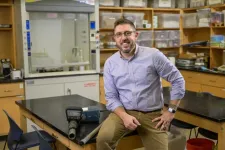(Press-News.org) SAN DIEGO, October 2, 2023 — A type of head and neck cancer predominantly diagnosed in people who reside in low- and middle-income countries may be treated effectively with fewer, but higher doses of radiation, a large new international study suggests.
The study – a randomized phase III clinical trial involving 10 countries across four continents – found delivering a course of radiation in 20 rather than 33 treatment sessions was just as effective at controlling cancer for patients with alcohol and tobacco-related, locally advanced disease, without increasing side effects. Findings from the HYPNO (HYPo- versus NOrmo-fractionated accelerated radiotherapy) trial will be presented today at the American Society for Radiation Oncology (ASTRO) Annual Meeting.
“Head and neck cancer caused by factors other than the human papillomavirus (HPV) remains a significant burden especially in lower- and middle-income countries,” said lead study author Søren Bentzen, PhD, DMSc, a professor of radiation oncology and Director of the Division of Biostatistics and Bioinformatics, Department of Epidemiology and Public Health, at the University of Maryland School of Medicine in Baltimore. “This is a trial that directly informs how you can effectively deliver radiation therapy to patients in a resource-scarce environment.”
Squamous cell head and neck cancers are the seventh most common type of cancer in the world, accounting for 450,000 deaths each year. Head and neck cancers have historically been associated with tobacco and alcohol use, including secondhand smoke and chewing tobacco. While head and neck cancers associated with the human papillomavirus (HPV) typically occur in younger, otherwise healthy people, cancers related to tobacco and alcohol generally affect older people who have comorbidities that can complicate treatment.
Unlike in the U.S. and many other high-income countries, the incidence of these cancers is rising in low- and middle-income countries, where rates already are disproportionately high. For example, head and neck cancers account for 30% of all cancer diagnoses in India, compared to 4-5% globally, and an estimated 84% of deaths from head and neck cancer occur in low- and middle-income countries.
Standard treatment for patients with locally advanced squamous cell head and neck cancers in these countries typically involves up to seven weeks of radiation therapy. Low- and middle-income countries often face a substantial undersupply of radiation therapy facilities, however, forcing many patients to travel great distances and remain away from home for long periods of time to receive care.
In this study, sponsored by the International Atomic Energy Agency in Vienna, Dr. Bentzen and his colleagues investigated whether a shorter course of radiation could be equally effective as standard treatment, without increasing the risk for side effects that could harm quality of life. Dr. Bentzen said the hypothesis grew out of years of mathematical modeling suggesting a shorter, more intense radiation course could deliver outcomes similar to current treatment regimens.
To test this model’s accuracy, he and his colleagues enrolled 792 patients from 12 health centers in 10 low- and middle-income countries: Uruguay, Brazil, Argentina, Cuba, South Africa, India, Pakistan, Thailand, Indonesia and the Philippines.
All participants in the trial had locally advanced head and neck cancer; a variety of tumor sites were represented, most commonly the oropharynx (50.5%). Patients were predominantly (87%) male, and most (87%) had a history of tobacco smoking or chewing. The majority (73%) were diagnosed with stage three or four cancer, with nearly half (49%) having cancer that had spread to the lymph nodes.
Patients were treated with radiation therapy in either 33 fractions (66 Gy, six fractions per week for 5.5 weeks) or 20 fractions (55 Gy, five fractions per week for 4 weeks). Most patients (76%) also received chemotherapy.
After three years, patients who received the accelerated treatment had roughly the same level of locoregional tumor control (test for non-inferiority within a 10% margin, p=0.041) and late-term side effects (test for non-inferiority within a 10% margin, p=0.004) as those who received the longer treatment. The overall survival and progression-free survival rates three years after treatment also were not significantly different between the groups (OS: p=0.62, 54.1% hypofractionated vs. 55.5% conventional; PFS: p=0.42, 44.0% vs. 45.3%).
“Accelerating radiation treatment is tricky because delivering too high a dose or too many doses too quickly can cause side effects that lower a person’s quality of life,” said Dr. Bentzen. “But not delivering enough radiation may allow the cancer to return.”
“There is actually a sweet spot where you get exactly the right balance between the total dose, the total treatment time and the dose you deliver in each fraction,” he said. “The net result is that you hit the tumor hard enough to get good control, but you don’t affect the normal tissue more than you would with the standard treatment.”
Dr. Bentzen said he and his team are completing additional subgroup analyses to confirm the accelerated regimen is effective for a wide variety of patient types, and initial findings suggest that it will be.
###
See this study presented:
News Briefing: Monday, October 2, 11:00 a.m. Pacific time. Details here. Register here.
Scientific Presentation: Plenary Session, Monday, October 2, 2:40 p.m. Pacific time, San Diego Convention Center. Email press@astro.org for access to the live stream or recording.
Abstract Title: Randomized controlled trial of hypofractionated vs. normo-fractionated accelerated radiation therapy with or without cisplatin for locally advanced head and neck squamous cell carcinoma (HYPNO) (LBA 02)
Attribution to the American Society for Radiation Oncology (ASTRO) Annual Meeting is requested in all coverage. View our meeting press kit at www.astro.org/annualmeetingpress.
ABOUT ASTRO
The American Society for Radiation Oncology (ASTRO) is the largest radiation oncology society in the world, with nearly 10,000 members who are physicians, nurses, biologists, physicists, radiation therapists, dosimetrists and other health care professionals who specialize in treating patients with radiation therapies. Radiation therapy contributes to 40% of global cancer cures, and more than a million Americans receive radiation treatments for cancer each year. For information on radiation therapy, visit RTAnswers.org. To learn more about ASTRO, visit our website and media center and follow us on social media.
END
Accelerated radiation treatment could reduce head and neck cancer patient burden in low- and middle-income countries
Shorter treatment course found as effective as longer schedule for people with non-HPV-related locally advanced disease
2023-10-02
ELSE PRESS RELEASES FROM THIS DATE:
October issues of American Psychiatric Association journals look at factors influencing depression and PTSD, guidance on handling drugs laced with fentanyl, and more
2023-10-02
The latest issues of three of the American Psychiatric Association’s journals, The American Journal of Psychiatry, Psychiatric Services and The American Journal of Psychotherapy are now available online.
The October issue of The American Journal of Psychiatry is focused on research devoted to understanding factors influencing depression, PTSD, and suicidal behavior. Highlights include:
Genetic Contribution to the Heterogeneity of Major Depressive Disorder: Evidence From a Sibling-Based Design Using Swedish National Registers.
Maternal Perinatal Stress Trajectories and Negative Affect and Amygdala Development in Offspring.
Networks of Neurodevelopmental Traits, Socioenvironmental ...
Men with metastatic prostate cancer live longer thanks to new drugs
2023-10-02
Survival rates for men with metastatic prostate cancer have increased by an average of six months, something which coincides with the gradual introduction of ‘dual treatment’ since 2016. This is according to a register study of all Swedish men diagnosed between 2008 and 2020. The results are published in the medical journal JAMA Network open.
Dual treatment means that patients receive both standard hormone therapy (GnRH therapy) and chemotherapy or androgen receptor blockers. Research has previously shown that men receiving this treatment live approximately one year longer than those receiving GnRH treatment alone.
“Dual treatment for men with newly diagnosed metastatic ...
A more effective experimental design for engineering a cell into a new state
2023-10-02
A strategy for cellular reprogramming involves using targeted genetic interventions to engineer a cell into a new state. The technique holds great promise in immunotherapy, for instance, where researchers could reprogram a patient’s T-cells so they are more potent cancer killers. Someday, the approach could also help identify life-saving cancer treatments or regenerative therapies that repair disease-ravaged organs.
But the human body has about 20,000 genes, and a genetic perturbation could be on a combination of genes or on any of the over 1,000 transcription factors that regulate the genes. ...
How the hippocampus distinguishes true and false memories
2023-10-02
Let’s say you typically eat eggs for breakfast but were running late and ate cereal. As you crunched on a spoonful of Raisin Bran, other contextual similarities remained: You ate at the same table, at the same time, preparing to go to the same job. When someone asks later what you had for breakfast, you incorrectly remember eating eggs.
This would be a real-world example of a false memory. But what happens in your brain before recalling eggs, compared to what would happen if you correctly recalled cereal?
In a paper published in Proceedings ...
Drier savannas, grasslands store more climate-buffering carbon than previously believed
2023-10-02
Photos
Savannas and grasslands in drier climates around the world store more heat-trapping carbon than scientists thought they did and are helping to slow the rate of climate warming, according to a new study.
The study, published online Oct. 2 in Nature Climate Change, is based on a reanalysis of datasets from 53 long-term fire-manipulation experiments worldwide, as well as a field-sampling campaign at six of those sites.
Twenty researchers from institutions around the globe, including two at the University of Michigan, looked at where and why fire has changed the amount of carbon stored in topsoil. They found that within savanna-grassland regions, ...
Ancient architecture inspires a window to the future
2023-10-02
A centuries-old technique for constructing arched stone windows has inspired a new way to form tailored nanoscale windows in porous functional materials called metal-organic frameworks (MOFs).
The method uses a molecular version of an architectural arch-forming “centring formwork“ template to direct the formation of MOFs with pore windows of predetermined shape and size.[1]. New MOFs designed and made in this way range from narrow-windowed materials with gas separation potential to larger-windowed structures with potential medical applications due to their excellent oxygen-adsorption capacity.
“One of the most challenging ...
Climate and human land use both play roles in Pacific island wildfires past and present
2023-10-02
DALLAS (SMU) – It’s long been understood that human settlement contributes to conditions that make Pacific Islands more susceptible to wildfires, such as the devastating Aug. 8 event that destroyed the Maui community of Lahaina. But a new study from SMU fire scientist Christopher Roos published in the journal Nature Ecology and Evolution shows that climate is an undervalued part of the equation.
Roos, SMU environmental archaeologist and professor of anthropology, traveled with his team to the Sigatoka ...
DeepMB: a deep learning framework for high-quality optoacoustic imaging in real-time
2023-10-02
Researchers at Helmholtz Munich and the Technical University of Munich have made significant progress in advancing high-resolution optoacoustic imaging for clinical use. Their innovative deep-learning framework, known as DeepMB, holds great promise for patients dealing with a range of illnesses, including breast cancer, Duchenne muscular dystrophy, and inflammatory bowel disease. Their findings have been now published in Nature Machine Intelligence.
In order to understand and detect diseases scientists and medical staff often rely on imaging methods such as ultrasound or X-ray. However, ...
Overlooked parts of proteins revealed as critical to fundamental functions of life
2023-10-02
According to textbooks, proteins work by folding into stable 3D shapes that, like Lego blocks, precisely fit with other biomolecules.
Yet this picture of proteins, the "workhorses of biology," is incomplete. Around half of all proteins have stringy, unstructured bits hanging off them, dubbed intrinsically disordered regions, or IDRs. Because IDRs have more dynamic, “shape-shifting” geometries, biologists have generally thought that they cannot have as precise of a fit with other biomolecules as their folded ...
Not the usual suspects: New interactive lineup boosts eyewitness accuracy
2023-10-02
Allowing eyewitnesses to dynamically explore digital faces using a new interactive procedure can significantly improve identification accuracy compared to the video lineup and photo array procedures used by police worldwide, a new study reveals.
Interactive lineups present digital 3D faces that witnesses can rotate and view from different angles using a computer mouse - enabling witnesses to actively explore and match faces to their recollection.
Publishing their findings today (2 Oct) in Proceedings of the National Academy of Sciences, psychologists found that the interactive procedure enhanced people’s ability to correctly identify perpetrators and avoid misidentifications.
Lead ...
LAST 30 PRESS RELEASES:
Making lighter work of calculating fluid and heat flow
Normalizing blood sugar can halve heart attack risk
Lowering blood sugar cuts heart attack risk in people with prediabetes
Study links genetic variants to risk of blinding eye disease in premature infants
Non-opioid ‘pain sponge’ therapy halts cartilage degeneration and relieves chronic pain
AI can pick up cultural values by mimicking how kids learn
China’s ecological redlines offer fast track to 30 x 30 global conservation goal
Invisible indoor threats: emerging household contaminants and their growing risks to human health
Adding antibody treatment to chemo boosts outcomes for children with rare cancer
Germline pathogenic variants among women without a history of breast cancer
Tanning beds triple melanoma risk, potentially causing broad DNA damage
Unique bond identified as key to viral infection speed
Indoor tanning makes youthful skin much older on a genetic level
Mouse model sheds new light on the causes and potential solutions to human GI problems linked to muscular dystrophy
The Journal of Nuclear Medicine ahead-of-print tip sheet: December 12, 2025
Smarter tools for peering into the microscopic world
Applications open for funding to conduct research in the Kinsey Institute archives
Global measure underestimates the severity of food insecurity
Child survivors of critical illness are missing out on timely follow up care
Risk-based vs annual breast cancer screening / the WISDOM randomized clinical trial
University of Toronto launches Electric Vehicle Innovation Ontario to accelerate advanced EV technologies and build Canada’s innovation advantage
Early relapse predicts poor outcomes in aggressive blood cancer
American College of Lifestyle Medicine applauds two CMS models aligned with lifestyle medicine practice and reimbursement
Clinical trial finds cannabis use not a barrier to quitting nicotine vaping
Supplemental nutrition assistance program policies and food insecurity
Switching immune cells to “night mode” could limit damage after a heart attack, study suggests
URI-based Global RIghts Project report spotlights continued troubling trends in worldwide inhumane treatment
Neutrophils are less aggressive at night, explaining why nighttime heart attacks cause less damage than daytime events
Menopausal hormone therapy may not pose breast cancer risk for women with BRCA mutations
Mobile health tool may improve quality of life for adolescent and young adult breast cancer survivors
[Press-News.org] Accelerated radiation treatment could reduce head and neck cancer patient burden in low- and middle-income countriesShorter treatment course found as effective as longer schedule for people with non-HPV-related locally advanced disease



